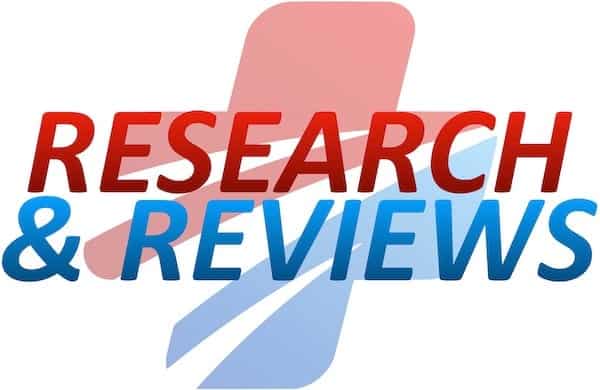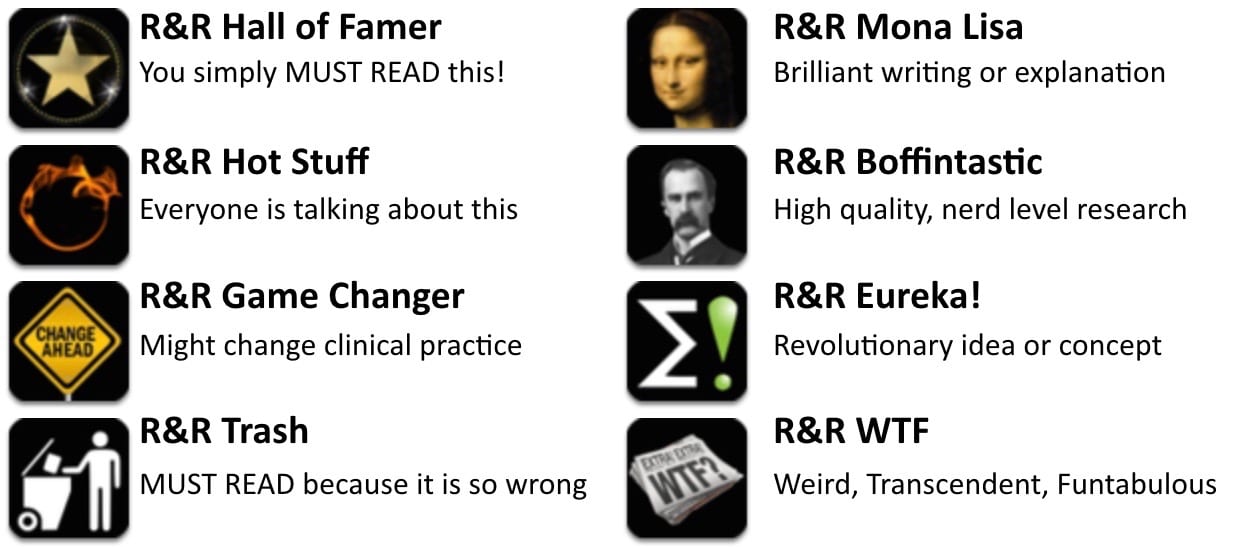R&R in the FASTLANE 015
Welcome to the 15th edition of Research and Reviews in the Fastlane. R&R in the Fastlane is a free resource that harnesses the power of social media to allow some of the best and brightest emergency medicine and critical care clinicians from all over the world tell us what they think is worth reading from the published literature.
This edition contains 8 recommended reads. The R&R Editorial Team includes Jeremy Fried, Nudrat Rashid, Soren Rudolph, Anand Swaminathan and, of course, Chris Nickson. Find more R&R in the Fastlane reviews in the : Overview; Archives and Contributors
This Edition’s R&R Hall of Famer
Crash-2 trial collaborators. Effects of tranexamic acid on death, vascular occlusive events, and blood transfusion in trauma patients with significant haemorrhage (CRASH-2): a randomised, placebo-controlled trial. Lancet. 2010 Jul 3;376(9734):23-32. PMID: 20554319
- The paper that started the debate on TXA in trauma, sparked several subgroup analysis papers and is slowly finding it’s way into clinical practice.
- Recommended by: John Larkin
- Learn more:
- EMCrit Podcast 67 – Tranexamic Acid (TXA), Crash 2, & Pragmatism with Tim Coats
- Emergency Medicine Ireland — Crash-2
- Emergency Medicine Literature of Note — Critique of Crash-2
- ICU Rounds Podcast — EARLY use of Tranexamic Acid may improve survival from bleeding in trauma
- The Lancet — Crash-2: Tranexamic Acid and Trauma Patients
- The NNT — Tranexamic acid for Trauma
Krumholz SD et al. Study of Neurontin: Titrate to Effect, Profile of Safety (STEPS) Trial. Arch Intern Med ;2011 Jun 27;171:1100-1107. Pubmed PMID: 21709111<
- So-called seeding trials are framed as phase 4 research, but are often designed and partially carried out by drug firms’ marketing departments to promote increased use of a specific drug. Disclosure of the true goal is made neither to the patients nor to participating clinicians. This must-read paper uses internal company memos obtained during product liability litigation to describe the whole sordid process.
- Recommended by: Leon Gussow
Bellomo R. The dangers of dogma in medicine. Med J Aust. 2011 Oct 3;195(7):372-3. PubMed PMID: 21978331.
- Written by an intensivist who has few rivals in his quest to bring light where there is darkness in medicine.
- An excerpt: “Doctors would do well to maintain a degree of cautious skepticism for both bold new fashions and received wisdom, whether generated by the world or by the self. They would do even better to question what they do and see such questioning as an asset. It is everyone’s responsibility to find out how to ask questions systematically, find answers from searching the literature, critically appraise the literature and apply the results to practice.”
- Recommended by: Chris Nickson
Berger E. Web 2.0 in Emergency Medicine: Specialty Embracing the Future of Medical Communication. Ann Emerg Med. 2012; 59(4) A21-A23 – [Full text]
- A sign that Web 2.0 is on the road to becoming mainstream for emergency phyisicians?
- Recommended by: Mike Cadogan
Parsons M, Spratt N, Bivard A, et al. A randomized trial of tenecteplase versus alteplase for acute ischemic stroke. N Engl J Med. 2012 Mar 22;366(12):1099-107. Pubmed PMID: 22435369
- There’s a new (old) TPA on the block – and 25 patients worth of data says it’s better than the old TPA. Good enough for the NEJM!
- Recommended by: Ryan Radecki
- Learn more: Emergency Medicine Literature of Note — TPA is dead! Long live TPA!
Hagihara A, Hasegawa M, Abe T, Nagata T, Wakata Y, Miyazaki S. Prehospital epinephrine use and survival among patients with out-of-hospital cardiac arrest. JAMA. 2012 Mar 21;307(11):1161-8. PubMed PMID: 22436956
- This massive Japanese observational study, like the brilliant Jacobs et al study finds that adrenaline (aka epi) increases ROSC. But it is associated (no causation implied by an observational study, remember) with worse outcomes in the longer term (survival AND neurological outcomes). Do we need a really big RCT? Can it be done? Are you going to stop giving epi? (But what else is there to give… SNP?)
- Recommended by: Chris Nickson, Ryan Radecki
- Learn more: Emergency Medicine Literature of Note — More Nails In the Coffin For Epinephrine, EMCrit Wee — Abandon Epinephrine?
Casey SJ, de Alwis WD. Review article: Emergency department assessment and management of stab wounds to the neck. Emerg Med Australas. 2010 Jun;22(3):201-10 PubMed PMID: 20497212.
- Avoid a trauma tribulation when faced with penetrating neck injuries.
- This is an excellent overview of the assessment and management of stab wounds to the neck.
- Recommended by: John Larkin
Jacobs IG, Finn JC, Jelinek GA, Oxer HF, Thompson PL. Effect of adrenaline on survival in out-of-hospital cardiac arrest: A randomised double-blind placebo-controlled trial. Resuscitation. 2011 Sep;82(9):1138-43. Epub 2011 Jul 2. PubMed PMID: 21745533.
- By now everyone knows this paper, but it needs to be on R&R… and not just because its from Western Australia (all power to Jacobs and Jelinek!). Commentators like John Marx on Journal Watch interpreted this as evidence of benefit for adrenaline as although it was underpowered, it found an increase in ROSC with epi that was not statistically significant. That’s all well and good but even if it was statistically significant, would it be clinically significant? Or could it even make things worse down the track?
- Recommended by: Chris Nickson
Chris is an Intensivist and ECMO specialist at The Alfred ICU, where he is Deputy Director (Education). He is a Clinical Adjunct Associate Professor at Monash University, the Lead for the Clinician Educator Incubator programme, and a CICM First Part Examiner.
He is an internationally recognised Clinician Educator with a passion for helping clinicians learn and for improving the clinical performance of individuals and collectives. He was one of the founders of the FOAM movement (Free Open-Access Medical education) has been recognised for his contributions to education with awards from ANZICS, ANZAHPE, and ACEM.
His one great achievement is being the father of three amazing children.
On Bluesky, he is @precordialthump.bsky.social and on the site that Elon has screwed up, he is @precordialthump.
| INTENSIVE | RAGE | Resuscitology | SMACC







